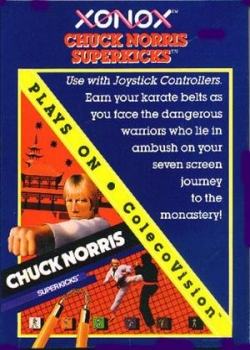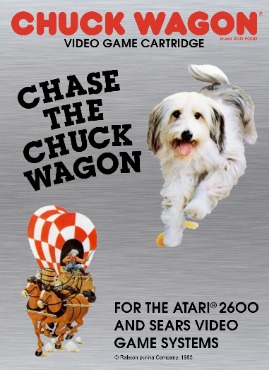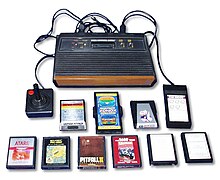
The Atari 2600 is a home video game console developed and produced by Atari, Inc. Released in September 1977 as the Atari Video Computer System, it popularized microprocessor-based hardware and games stored on swappable ROM cartridges, a format first used with the Fairchild Channel F in 1976. The VCS was bundled with two joystick controllers, a conjoined pair of paddle controllers, and a game cartridge—initially Combat and later Pac-Man. Sears sold the system as the Tele-Games Video Arcade. Atari rebranded the VCS as the Atari 2600 in November 1982, alongside the release of the Atari 5200.

The Atari 5200 SuperSystem or simply Atari 5200 is a home video game console introduced in 1982 by Atari, Inc. as a higher-end complement for the popular Atari Video Computer System. The VCS was renamed to Atari 2600 at the time of the 5200's launch. Created to compete with Mattel's Intellivision, the 5200 wound up a direct competitor of ColecoVision shortly after its release. While the Coleco system shipped with the first home version of Nintendo's Donkey Kong, the 5200 included the 1978 arcade game Super Breakout, which had already appeared on previous Atari home platforms.

The Atari 7800 ProSystem, or simply the Atari 7800, is a home video game console officially released by Atari Corporation in 1986 as the successor to both the Atari 2600 and Atari 5200. It can run almost all Atari 2600 cartridges, making it one of the first consoles with backward compatibility. It shipped with a different joystick than the 2600-standard CX40 and included Pole Position II as the pack-in game. The European model has a gamepad instead of a joystick. Most of the early releases for the system are ports of 1981–1983 arcade video games. The final wave of 7800 cartridges are closer in style to what was available on other late 1980s consoles, such as Scrapyard Dog and Midnight Mutants.

Joseph Warren Robinett Jr. is a designer of interactive computer graphics software, notable as the developer of the Atari 2600's Adventure and as a founder of The Learning Company, where he designed Rocky's Boots and Robot Odyssey. More recently he has worked on virtual reality projects.

Howard Scott Warshaw, also known as HSW, is an American psychotherapist and former game designer. He worked at Atari, Inc. in the early 1980s, where he designed and programmed the Atari 2600 games Yars' Revenge, Raiders of the Lost Ark, and E.T. the Extra-Terrestrial.

Chuck Norris Superkicks is a video game produced by Xonox in 1984. It was later sold as Kung Fu Superkicks and Super Kung Fu when the license for the use of the name Chuck Norris expired. The game was produced for the Commodore 64, VIC-20, Atari 2600, and ColecoVision as part of Xonox's double-ender cartridge line.

The TV Boy, and its successors TV Boy II and Super TV Boy, are handheld TV games sold by many different companies, including Systema, Akor, and NICS, based upon an unlicensed clone of Atari 2600 hardware. They were released around 1992 and three years later, an improved version of the TV Boy 2, the Super TV Boy, was also made by Akor. They were widely available across Europe. In the UK, they were most visibly available through Argos.
1982 was the peak year for the golden age of arcade video games as well as the second generation of video game consoles. Many games were released that would spawn franchises, or at least sequels, including Dig Dug, Pole Position, Mr. Do!, Zaxxon, Q*bert, Time Pilot and Pitfall! The year's highest-grossing video game was Namco's arcade game Pac-Man, for the third year in a row, while the year's best-selling home system was the Atari 2600. Additional video game consoles added to a crowded market, notably the ColecoVision and Atari 5200. Troubles at Atari late in the year triggered the video game crash of 1983.

Home Entertainment Suppliers Pty. Ltd. is an Australian company that distributes computer games and gaming equipment. HES' offices are based in Riverwood, Sydney. HES's founder and managing director is Sebastian Giompaolo.

Chase the Chuck Wagon is a 1983 promotional video game written by Mike Schwartz for the Atari 2600 and distributed by Purina. It was available only via mail order by sending in proofs of purchase to Purina. In the 1970s and 1980s, popular television commercials for Purina dog food included a dog chasing a tiny chuckwagon. The gameplay is loosely based on this premise.

Artillery Duel is an artillery game originally written for the Bally Astrocade by Perkins Engineering and published by Bally in 1982. John Perkins wrote the game first in Astro BASIC, submitting it to The Arcadian fanzine, from which it was adapted for the Astro BASIC manual. Perkins subsequently developed the Astrocade cartridge.

Rebecca Ann Heineman is an American video game designer and programmer. Heineman was a founding member of video game companies Interplay Productions, Logicware, Contraband Entertainment, and Olde Sküül. She has been chief executive officer for Olde Sküül since 2013.
In the history of video games, the second-generation era refers to computer and video games, video game consoles, and handheld video game consoles available from 1976 to 1992. Notable platforms of the second generation include the Fairchild Channel F, Atari 2600, Intellivision, Odyssey 2, and ColecoVision. The generation began in November 1976 with the release of the Fairchild Channel F. This was followed by the Atari 2600 in 1977, Magnavox Odyssey² in 1978, Intellivision in 1980 and then the Emerson Arcadia 2001, ColecoVision, Atari 5200, and Vectrex, all in 1982. By the end of the era, there were over 15 different consoles. It coincided with, and was partly fuelled by, the golden age of arcade video games. This peak era of popularity and innovation for the medium resulted in many games for second generation home consoles being ports of arcade games. Space Invaders, the first "killer app" arcade game to be ported, was released in 1980 for the Atari 2600, though earlier Atari-published arcade games were ported to the 2600 previously. Coleco packaged Nintendo's Donkey Kong with the ColecoVision when it was released in August 1982.

Pac-Man is a 1982 maze video game developed and published by Atari, Inc. under official license by Namco, and an adaptation of the 1980 arcade game Pac-Man. The player controls the title character, who attempts to consume all of the wafers in a maze while avoiding four ghosts that pursue him. Eating flashing wafers at the corners of the screen causes the ghosts to temporarily turn blue and flee, allowing Pac-Man to eat them for bonus points. Once eaten, a ghost is reduced to a pair of eyes, which return to the center of the maze to be restored.
Ghost Manor is a horror video game released by Xonox in 1983 for the Atari 2600 and VIC-20. It was packaged in a double ended cartridge and a cassette tape along with one of three other games in an effort to appeal to budget conscious buyers who would purchase two games for the price of one cartridge and one cassette tape. There was also a more limited release of single ended cartridges and cassette tapes containing Ghost Manor by itself. The double ended cartridges and cassette tapes paired Ghost Manor with the platform game Spike's Peak, the fighting game Chuck Norris Superkicks, and a strategy game called Artillery Duel.

The Atari video game burial was a mass burial of unsold video game cartridges, consoles, and computers in a New Mexico landfill site undertaken by the American video game and home computer company Atari, Inc. in 1983. Before 2014, the goods buried were rumored to be unsold copies of E.T. the Extra-Terrestrial (1982), one of the largest commercial video game failures and often cited as one of the worst video games ever released, and the 1982 Atari 2600 port of Pac-Man, which was commercially successful but critically maligned.

Slot Racers is a video game for the Atari VCS published by Atari, Inc. in 1978. It was designed by Warren Robinett, who went on to create one of Atari's most famous games Adventure.
Telegames, Inc. is an American video game company based in Mabank, Texas, with a sister operation based in England.

The first hobbyist-developed game for the Atari 2600 video game console was written in 1995, and more than 100 have been released since then. The majority of games are unlicensed clones of games for other platforms, and there are some also original games and ROM hacks. With only 128 bytes of RAM, no frame buffer, and the code and visuals closely intertwined, the 2600 is a difficult machine to program. and many games were written for the technical challenge. Emulators, programming tools, and documentation are available.

















